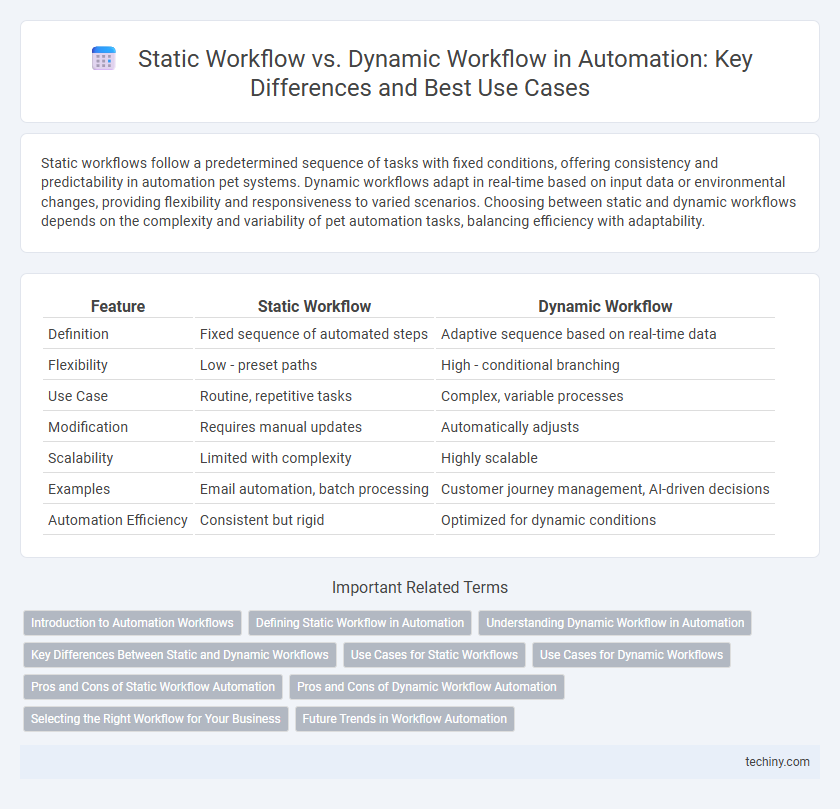Static workflows follow a predetermined sequence of tasks with fixed conditions, offering consistency and predictability in automation pet systems. Dynamic workflows adapt in real-time based on input data or environmental changes, providing flexibility and responsiveness to varied scenarios. Choosing between static and dynamic workflows depends on the complexity and variability of pet automation tasks, balancing efficiency with adaptability.
Table of Comparison
| Feature | Static Workflow | Dynamic Workflow |
|---|---|---|
| Definition | Fixed sequence of automated steps | Adaptive sequence based on real-time data |
| Flexibility | Low - preset paths | High - conditional branching |
| Use Case | Routine, repetitive tasks | Complex, variable processes |
| Modification | Requires manual updates | Automatically adjusts |
| Scalability | Limited with complexity | Highly scalable |
| Examples | Email automation, batch processing | Customer journey management, AI-driven decisions |
| Automation Efficiency | Consistent but rigid | Optimized for dynamic conditions |
Introduction to Automation Workflows
Static workflows follow predefined, fixed sequences of tasks, ensuring consistent automation execution but lacking flexibility for changing conditions. Dynamic workflows adapt in real-time based on input data or system events, enabling personalized and responsive automation processes. Understanding the balance between static and dynamic workflows is essential for designing efficient automation solutions that optimize performance and scalability.
Defining Static Workflow in Automation
Static workflow in automation involves pre-defined, fixed sequences of tasks or processes that follow a set path without alteration during execution. These workflows are designed for repetitive, predictable tasks where consistency and minimal variation are critical, enhancing efficiency in structured environments. Static workflows are essential in robotic process automation (RPA) systems for process standardization and reducing human intervention.
Understanding Dynamic Workflow in Automation
Dynamic workflow in automation adapts in real-time based on incoming data and conditions, enabling more flexible and responsive processes compared to static workflows that follow predefined, unchanging sequences. This adaptability allows businesses to handle complex scenarios such as conditional routing, exception handling, and on-the-fly decision-making. Leveraging AI and machine learning enhances dynamic workflows by continuously optimizing process efficiency and reducing manual intervention.
Key Differences Between Static and Dynamic Workflows
Static workflows follow predefined, rigid sequences that remain consistent regardless of changing conditions, ensuring predictability but limiting flexibility. Dynamic workflows adapt in real-time by incorporating decision logic and conditional paths, enabling responsiveness to varying inputs and business rules. Key differences include static workflows' simplicity and stability versus dynamic workflows' complexity and ability to handle exceptions and evolving processes.
Use Cases for Static Workflows
Static workflows excel in processes with well-defined, repetitive tasks such as invoice processing, employee onboarding, and compliance reporting, where each step follows a predetermined sequence. These workflows enhance efficiency and minimize errors by automating routine operations without requiring real-time adjustments. Static workflows are ideal for industries like finance, HR, and manufacturing, where consistency and predictability are critical for regulatory adherence and operational stability.
Use Cases for Dynamic Workflows
Dynamic workflows excel in environments requiring real-time decision-making and adaptability, such as customer support systems where queries vary widely. They enable automated adjustments based on user input, process outcomes, or changing data, ideal for complex business processes like order fulfillment with variable paths. Use cases also include IT incident management and personalized marketing campaigns where flexibility and responsiveness enhance efficiency and user experience.
Pros and Cons of Static Workflow Automation
Static workflow automation offers predictable, repeatable processes that enhance efficiency and reduce errors in routine tasks. Its fixed sequence ensures stability and easier compliance but limits flexibility when handling exceptions or adapting to changing requirements. This rigidity can hinder scalability and responsiveness in dynamic business environments where variability is common.
Pros and Cons of Dynamic Workflow Automation
Dynamic workflow automation adapts in real-time to changing data inputs and conditions, enabling more flexible and responsive process management compared to static workflows. It excels in handling complex, variable business processes by allowing customization without manual intervention, which enhances efficiency and reduces errors. However, its complexity can lead to higher implementation costs and require advanced technical expertise to design and maintain effectively.
Selecting the Right Workflow for Your Business
Selecting the right workflow between static and dynamic automation depends on your business requirements and process complexity. Static workflows are ideal for repetitive, predictable tasks with fixed sequences, ensuring consistency and efficiency. Dynamic workflows suit businesses needing adaptability, allowing processes to change based on real-time data, user input, or exceptions to optimize performance and responsiveness.
Future Trends in Workflow Automation
Static workflows follow predefined, rigid sequences that limit adaptability, while dynamic workflows leverage AI and machine learning to enable real-time decision-making and process adjustments. Future trends in workflow automation emphasize increased integration of predictive analytics, robotic process automation (RPA), and cloud-based platforms to create smarter, more flexible workflows. These advancements drive operational efficiency, scalability, and enhanced user experience across industries.
Static Workflow vs Dynamic Workflow Infographic

 techiny.com
techiny.com